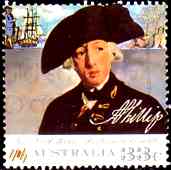
Captain Arthur Phillip
|
Maritime Topics On Stamps :
- The First Fleet -
|
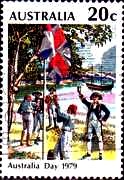
Australia Day
|
|
Between 1788 and 1850 the English sent over 162,000 convicts to Australia in 806 ships.
The first eleven of these ships are today known as the First Fleet and contained the convicts
and marines that are now acknowledged as the founders of Australia.
| |
During the 18th century the population of the British cities sky-rocketed. Most people were
poor and made their living with robberies and other small crimes. The overall crime rate
climbed to new record highs, the jails became heavily overcrowded. In 1770 Captain Cook had
charted the east coast of Australia and categorized it as a good area for settlement. After
reviewing his reports the British Crown decided to found a penal colony there.
|
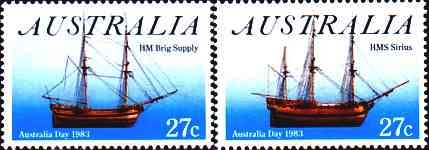
|
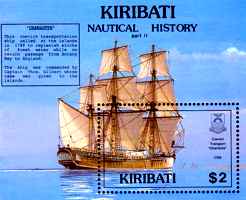
|
The First Fleet consisted of two navy ships (Sirius, Supply ),
three supply ships (Friendship, Borrowdale, Golden Grove) and
six transport ships for convicts (Alexander,
Charlotte, Fishburn, Lady Penrhyn, Prince of Wales und Scarborough ).
They were under the command of captain Arthur Phillip, see above, stamp to the left.
We can see the HMS Sirius and HMT Supply on the stamps to the right, and the Charlotte
to the left on the souvenir sheet. Some specifications about these three ships:
|
HMS Sirius, man of war / flagship, 540 tons, L - 110 ft, B - 32, 14 guns
HMT Supply, armed tender / brig, 170 tons, L - 70 ft, B - 26 ft
Charlotte, transport ship / barque, 335 tons, L - 105 ft, B - 28 ft
|
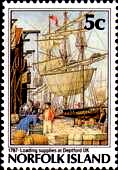
|
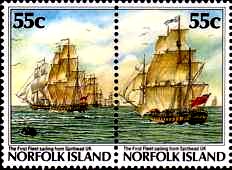
|
All in all there were 759 convicts aboard these ships, 568 male and 191 female. In addition
the crew consisted of sailors, marines and some civil officers, who were supposed to stay
at the colony until it became self-sufficient. The documents listing crew, livestock
and provisions have survived over the centuries. A lot of animals were aboard as well e.g. horses,
calves, sheeps, geese, hogs, ducks, fowls, turkeys and rabbits. All in all the supplies
were supposed to last for two years.
On the stamp to the left you can see the loading of the ships, to the right the fleet with
the 'Sirius' up in front.
|

| |
The First Fleet left the British port of Portsmouth on May the 13th, 1787. Its destination
was the Botany Bay at Australia. In 1987, in memory of the 200th anniversary of the voyage,
Australia issued the following five stamp-rows. The first stamp row is named 'Departure'.
Beginning from the left you can see embarkment of the convicts, a navy officer with his
wife and some sailors, who are loading goods and transporting them to the ships. On the
stamp to the right you can see the Supply in the foreground, and the Sirius
in the back. After leaving the English Channel the fleet had to fight heavy gale and
high seas for 10 days.
|
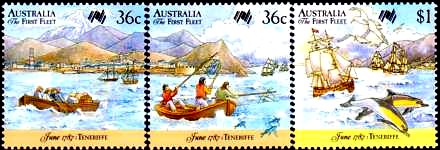
| |
On June the 3rd, 1787 the fleet entered the port of Santa Cruz on Teneriffe, part of
the Canary Islands. Fresh water and vegetables were loaded aboard. The Spanish governor
welcomed the captains and officers and invited them to dine with him during their stay.
One convict escaped from the Alexander, but he was captured on the following
day. On the three stamps named 'Teneriffe' you can see a boat with a fresh water barrel,
local fishermen with flying bonitos and to the right the arrival of the fleet with
the Sirius in the foreground.
|

| |
After a short stay the fleet left Teneriffe and crossed the Atlantic Ocean, heading for their next
port of call, Rio de Janeiro, which was named San Sebastian in those days. The course
was chosen to sail along the Northeast Trade Winds and to avoid tack courses
against the Southeast Trade Winds off the coas t of West-Africa. The voyage took eight weeks,
and by August the 6th, 1787, the fleet dropped anchor in the harbour of Rio de Janeiro.
Captain Phillip was saluted with gunshots because he had served in the Portuguese Navy
in earlier days. On the stamps to the left you can see the arrival, in the middle a market place
with a procession and to the right the fleet leaving the harbour.
|
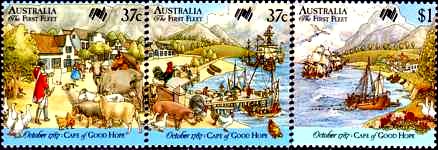
| |
After leaving Rio the fleet ran into strong gales and some of the ships were damaged. On board of
the Alexander a mutiny was cast down, aboard the Friendship a brawl
among the officers broke out, and the crew of the Sirius discovered several layers of
rotted wood in the hull. Finally, on the morning of October the 13th, 1887, land was sighted,
and by dark all eleven ships were safely anchored in Table Bay off Cape Town. In those days
Cape Town was a Dutch colony to supply the ships of the East-Indian Company. The First
Fleet took on fresh water, fresh meat, vegetables and some cattle aboard. On November
the 12th the voyage continued. On the stamps named 'Cape of Good Hope' you can see an officer
checking the cattle, in the middle the loading of the ships and to the right two ships off
the South-African coast.
|

|
In Cape Town Captain Phillip went aboard the Supply and together with three
fast transport ships Alexander, Friendship und Scarboruogh sailed ahead. His
plan was to seek out the best possible site for the proposed settlement before
the main fleet arrived. It was an uncomfortable and stormy voyage lasting over eight weeks.
The Supply reached Botany Bay on January the 18th, 1788, The three transport ships
took a day longer and the rest of the fleet arrived on January the 20th. The British
were very surprised to sight the French ships L'Astrolabe and La Bodeuse of La
Perouse at the entrance of Botany Bay.
On the stamps labelled 'Arrival' the Supply is depicted entering the Botany Bay.
They are observed by the natives, the so-called Aboriginals and some kangaroos. To the middle
landfall and to the right crew members hoisting the British flag (see next paragraph).
|
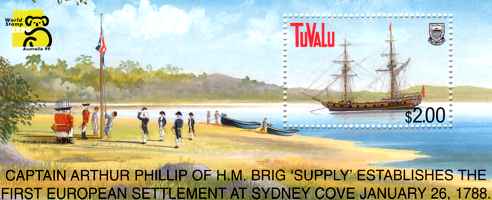
| |
Captain Phillip decided Botany Bay was not suitable for a settlement because they
found not enough fresh water. So the fleet sailed north amd found Port Jackson, 'one of
the finest harbours of the world'. It was the bight of what today is called Sydney (Sydney Cove
to be precise). The settlement was established at the site of todays famous opera house. On
January the 26th the whole fleet dropped anchor and on the same day the flag was hoisted.
This date marks the foundation of the Australian nation and is celebrated annually as the
Australian Day - see stamp on top of this page. Captain Arthur Phillip became the first governor
of the colony.
|
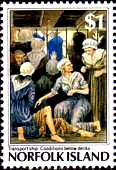
|
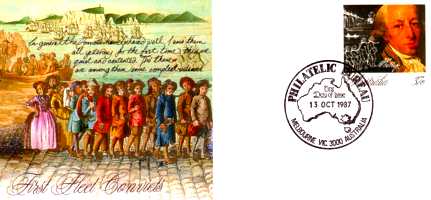
| |
23 convicts died on the voyage to Australia. That was a small number in comparison to
later voyages. On the stamp to the left you can see a convict lying on the floor. Chains
are attached to his feet and some women are attending him. Besides the mutiny aboard the
Alexander another vain mutiny attempt happened aboard the Scarborough. On the
letter above you can see a picture of the 'First Fleet convicts', and how they were brought
ashore. On the stamp Captain Phillip is depicted.
|
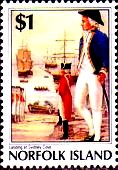
|
Besides the sailors and the convicts a small detachment of marines sailed with the First
Fleet. Their duty was to guard the prisoners and to protect the settlement against natives
and other outer influences. On the stamp 'landing at Sydney Cove' you can see the marines
in red jackets. The sailors wore blue jackets.
Then there was a group of civilians aboard - women and cildren of the marines and the
convicts. Among them doctors, a chaplan and government authorities.
|
|
It was a difficult start for the settlers. The main problem was food. The soil was poor,
only few plants were eatable and the convicts were only moderate fishermen.
They depended on the supplies brought by the ships. Everyone, from the convicts to
Captain Phillip was on rations. Rats, dogs, crows, and the occasional kangaroo were
used to supplement the menu. During 1788 all the ships, except the
Sirius and the Supply, left for England and China.
|
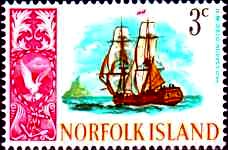
|
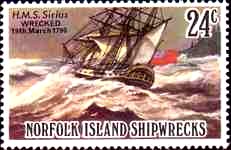
|
In Octobre 1788 the Sirius was sent to Cape Town to purchase provisions. She returned
in May 1789, but during this time the Supply shipped a small contingent of convicts
and marines to Norfolk Island to set up another penal colony. She sailed on to Batavia to
get supplies. The settlers had two difficult years until the first ships
of the second fleet arrived in June 1790. The first free settlers reached Australia in
1793.
| |
The Sirius ran on a reef off Norfolk Island, depicted on the stamp. For this event
several dates exist throughout the literature: February 19th, March 19th, April 14th, 1790
and only 1791.
|
|
The Aboriginals were treated like 'Indians' by the settlers. This attitude created
a problem, which is not really solved up to today. To the right you can see
the former Coat of Arms of Sydney. We see an Aborigine and a British sailor on both
sides of a shield with a ship. Underneath the motto: 'I take but I surrender '. In
1996 this Coat of Arms was dropped for another design, showing a shield with an anchor
and a crown without the two persons.
|
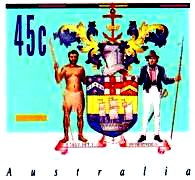
|
The topics of the five 'Arrival' stamps are also issued from the post authorities of
Christmas Island and Cocos (Keeling) Island. On her homebound voyage the Charlotte
entered the islands of Kiribati to load fresh water. The souvenir sheet shown above was
issued in memory of that date.
Thera are a lots of stamps more about the Supply and the Sirius than depicted
here (issued from Australia and Norfolk Island).
If You want to see the page about the first voyage
of Captain Cook, where he discovered Botany Bay, then click on this line.
|
Source: Navicula's S. Dombrowsky and different Internet pages.
|